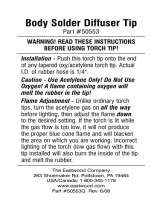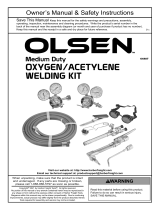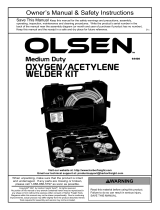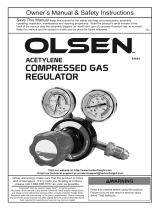Page is loading ...

Due to continuing improvements, actual product may differ slightly from the product described herein.
3491 Mission Oaks Blvd., Camarillo, CA 93011
Visit our Web site at: http://www.harborfreight.com
Copyright
©
2007 by Harbor Freight Tools
®
. All rights reserved. No portion of this
manual or any artwork contained herein may be reproduced in any shape or form
without the express written consent of Harbor Freight Tools.
®
Model 95671
WELDING TORCH MINI-KIT
ASSEMBLY AND OPERATING INSTRUCTIONS
For technical questions, please call 1-800-444-3353.

PRODUCT SPECIFICATIONS
SAVE THIS MANUAL
You will need this manual for the safety warnings and precautions, assembly,
operating, inspection, maintenance and cleaning procedures, parts list and assembly
diagram. Keep your invoice with this manual. Write the invoice number on the
inside of the front cover. Keep this manual and invoice in a safe and dry place for
future reference.
GENERAL SAFETY RULES
WARNING!
READ AND UNDERSTAND ALL INSTRUCTIONS
Failure to follow all instructions listed below may result in
fire, and/or serious injury.
SAVE THESE INSTRUCTIONS
WORK AREA
1. Keep your work area clean and well lit. Cluttered benches and dark areas
invite accidents.
2. Do not operate welding equipment in explosive atmospheres, such as in
the presence of flammable liquids, gases, or dust. Welding equipment
create sparks which may ignite the dust or fumes.
SKU 95671 For technical questions, please call 1-800-444-3353 PAGE 2
Item Description
Product
Applications
Used for jewelry, hobby crafts, metal sculptures, electronics, etc.
Can be used with acetylene, hydrogen, propane, or natural gas.
Required Gas
Pressure
0.2mm Tip = 2 PSI Oxygen / 2 PSI Fuel
0.3mm Tip = 3 PSI Oxygen / 3 PSI Fuel
0.4mm Tip = 4 PSI Oxygen / 4 PSI Fuel
0.5mm Tip = 6 PSI Oxygen / 5 PSI Fuel
0.6mm Tip = 6 PSI Oxygen / 6 PSI Fuel
Hose Assembly 6 Ft. Long / Color-Coded (Red & Green)
9/16” x 18 NPT Brass Connectors Braided
Additional
Features
Aluminum Alloy Body / Copper Tips with Rubber O-Rings
Oxygen Adjustment Knob / Fuel Gas Adjustment Knob
Accessories 0.2mm Tip (Qty. 1) / 0.3mm Tip (Qty. 1)
0.4mm Tip (Qty. 1) / 0.5mm Tip (Qty. 1) / 0.6mm Tip (Qty. 1)
Weight 0.35 Pound

3. Keep bystanders, children, and visitors away while operating welding
equipment. Distractions can cause you to lose control. Protect others in the
work area from debris such as chips and sparks. Provide barriers or shields as
needed. Children should not be allowed in the work area.
5. Dress properly. Do not wear loose clothing or jewelry. Contain long hair.
Keep your hair, clothing, and gloves away from moving parts. Loose clothes,
jewelry, or long hair can be caught in moving parts.
6. Do not overreach. Keep proper footing and balance at all times. Proper footing
and balance enables better control of the tool in unexpected situations.
TOOL USE AND CARE
7. Use clamps (not included) or other practical ways to secure and support the
workpiece to a stable platform. Holding the work by hand or against your body is
unstable and may lead to loss of control.
8. Do not force the tool. Use the correct tool for your application. The correct
tool will do the job better and safer at the rate for which it is designed.
SKU 95671 For technical questions, please call 1-800-444-3353 PAGE 3
9. Store idle tools out of reach of children and other untrained persons. Tools
are dangerous in the hands of untrained users.
10. Maintain tools with care. Keep the welding equipment clean. Properly
maintained tools are less likely to malfunction and are easier to control. Do not use
a damaged tool. Tag damaged tools “Do not use” until repaired.
11. Check for misalignment or binding of moving parts, breakage of parts, and
any other condition that may affect the tool’s operation. If damaged, have the
tool serviced before using. Many accidents are caused by poorly maintained
tools.
12. Use only accessories that are recommended by the manufacturer for your
model. Accessories that may be suitable for one tool may become hazardous
when used on another tool.
PERSONAL SAFETY
4. Stay alert. Watch what you are doing, and use common sense when oper-
ating welding equipment. Do not use welding equipment while tired or
under the influence of drugs, alcohol, or medication. A moment of inatten-
tion while operating welding equipment may result in serious personal injury.

13. Tool service must be performed only by qualified repair personnel. Service
or maintenance performed by unqualified personnel could result in a risk of injury.
14. When servicing a tool, use only identical replacement parts. Follow
instructions in the
“Inspection, Maintenance, And Cleaning”
section of this
manual. Use of unauthorized parts or failure to follow maintenance instructions
may create a risk of electric shock or injury.
SERVICE
SPECIFIC SAFETY RULES
1. Maintain labels and nameplates on the Welding Torch Mini-Kit. These carry
important information. If unreadable or missing, contact Harbor Freight Tools for
a replacement.
2. Maintain a safe working environment. Keep the work area well lit. Make sure
there is adequate surrounding workspace. Always keep the work area free of
obstructions, grease, oil, trash, and other debris.
3. Prevent eye injury and burns. Wearing and using personal safety clothing and
safety devices reduce the risk for injury. Wear ANSI approved welding goggles (not
included) featuring at least a number 10 shade lens rating. Leather leggings, fire
resistant shoes or boots should be worn when using this product. Do not wear
pants with cuffs, shirts with open pockets, or any clothing that can catch and hold
molten metal or sparks. Keep clothing free of grease, oil, solvents, or any flammable
substances. Wear dry, insulating gloves and protective clothing. Wear an approved
head covering to protect the head and neck. Use aprons, cape, sleeves, shoulder
covers, and bibs designed and approved for welding and cutting procedures. When
welding or cutting overhead or in confined spaces, wear flame resistant ear plugs or
ear muffs to keep sparks out of ears.
4. Prevent accidental fires. Remove any combustible material from the work area.
When possible, move the work to a location well away from combustible materials.
If relocation is not possible, protect the combustibles with a cover made of fire
resistant material. Remove or make safe all combustible materials for a radius of 35
feet (10 meters) around the work area. Use a fire resistant material to cover or
block all open doorways, windows, cracks, and other openings. Enclose the work
area with portable fire resistant screens. Protect combustible walls, ceilings, floors,
etc., from sparks and heat with fire resistant covers. If working on a metal wall,
ceiling, etc., prevent ignition of combustibles on the other side by moving the
combustibles to a safe location. If relocation of combustibles is not possible, designate
someone to serve as a fire watch, equipped with a fire extinguisher, during the
welding process and for at least one half hour after the welding is completed. Do
not weld or cut on materials having a combustible coating or combustible internal
SKU 95671 For technical questions, please call 1-800-444-3353 PAGE 4

structure, as in walls or ceilings, without an approved method for eliminating the
hazard. Do not dispose of hot slag in containers holding combustible materials.
Keep a fire extinguisher nearby and know how to use it. After welding or cutting,
make a thorough examination for evidence of fire. Be aware that easily visible
smoke or flame may not be present for some time after the fire has started. Do not
weld or cut in atmospheres containing dangerously reactive or flammable gases,
vapors, liquids, and dust. Provide adequate ventilation in work areas to prevent
accumulation of flammable gases, vapors, and dust. Do not apply heat to a container
that has held an unknown substance or a combustible material whose contents,
when heated, can produce flammable or explosive vapors. Clean and purge
containers before applying heat. Vent closed containers, including castings, before
preheating, welding, or cutting.
5. Avoid overexposure to fumes and gases. Always keep your head out of the
fumes. Do not breathe the fumes. Use enough ventilation or exhaust, or both, to
keep fumes and gases from your breathing zone and general area. Where ventilation
is questionable, have a qualified technician take an air sampling to determine the
need for corrective measures. Use mechanical ventilation to improve air quality. If
engineering controls are not feasible, use an approved respirator. Work in a confined
area only if it is well ventilated, or while wearing an air-supplied respirator. Follow
OSHA guidelines for Permissible Exposure Limits (PEL’s) for various fumes and
gases. Follow the American Conference of Governmental Industrial Hygienists
recommendations for Threshold Limit Values (TLV’s) for fumes and gases. Have a
recognized specialist in Industrial Hygiene or Environmental Services check the
operation and air quality and make recommendations for the specific welding or
cutting situation.
SKU 95671 For technical questions, please call 1-800-444-3353 PAGE 5

7. Read and understand all instructions and safety precautions as outlined in
the manufacturer’s manual for the material you will weld or cut.
6. Always keep the Welding Hoses (7, 8) away from moving parts on the tool.
Examine the Welding Hoses for cuts, burns, or worn areas before each use. If any
damaged areas are found, replace the Welding Hoses immediately.
8. Proper cylinder care. Secure cylinders to a cart, wall, or post, to prevent them
from falling. All cylinders should be used and stored in an upright position.
Never drop or strike a cylinder. Do not use cylinders that have been dented.
Cylinder caps should be used when moving or storing cylinders. Empty cylinders
should be kept in specified areas and clearly marked “empty”.
9. Never use oil or grease on any inlet connector, outlet connector, or cylin-
der valves.
10. Always use reverse-flow check valves (not included) on the torch and
regulator. This greatly reduces the possibility of mixing gases in the regulator or
hose.
11. Working pressure on the Acetylene Regulator should NEVER be set above
6 PSI.
12. For the Cutting Attachment, inspect the tapered seating surfaces on the
Tip and in the Torch Head. Have a qualified technician resurface the seat area
if it has dents, burrs, or is burned. A poor seating surface may result in
backfire
or
flashback
.
13. Backfire and flashback. When the flame goes out with a loud “pop”, it is called
a
backfire
. Backfire can be caused by (1) operating the Torch at lower pressures
than required for the Tip used, (2) touching the Tip against the workpiece, (3)
overheating the Tip, or (4) an obstruction in the Tip. If backfire occurs, shut off
the Torch Handle Valves (oxygen first) and after remedying the cause, relight the
Torch. A
flashback
is a condition that results when the flame flashes back into
the Torch and burns inside with a shrill hissing or squealing noise. If flashback
occurs, close the Torch Handle Valves (oxygen first), IMMEDIATELY. Flashback
generally indicates a problem that should be repaired. A clogged Tip, improper
functioning of the Valves, or incorrect acetylene/oxygen pressure could lead to
flashback. Make sure to find the cause before relighting the Torch.
14. WARNING! This product, when used for welding and similar applica-
tions, contains or produces a chemical known to the State of California to
cause cancer and birth defects (or other reproductive harm).
(California Health & Safety Code 25249.5 et seq.)
15. WARNING! The brass components of this product contain lead, a
SKU 95671 For technical questions, please call 1-800-444-3353 PAGE 6

chemical known to the State of California to cause birth defects (or other
reproductive harm).
(California Health & Safety Code 25249.5 et seq.)
When unpacking, check to make sure all the parts shown on the Parts List on page 11 are
included. If any parts are missing or broken, please call Harbor Freight Tools at the number
shown on the cover of this manual as soon as possible.
UNPACKING
ASSEMBLY AND OPERATING INSTRUCTIONS
NOTE:
For additional information regarding the parts listed in the
following pages, refer to the Assembly Diagram on page 11.
1. IMPORTANT! The following instructions are for
acetylene
gas use only.
Contact your gas supplier for instructions on the use of other fuel gases.
2. Make sure to secure the cylinders (as noted in the
Specific Safety Rules
sec-
tion).
3. While standing to one side, “crack” each cylinder valve. “Cracking” is to quickly
open and close the valve, allowing gas to escape and clearing the valve of any
foreign material. WARNING! If oil or grease is found, discontinue using
cylinder and immediately contact your supplier. (See Figure A.)
QUICKLY
OPEN/CLOSE
VALVE TO
“CRACK”
ACETYLENE
OR
OXYGEN
CYLINDER
(NOT INCLUDED)
FIGURE A
CYLINDER
VALVE
HANDLE
4. Attach the GREEN Oxygen Hose (7) to the oxygen cylinder. Then, attach the RED
Acetylene Hose (8) to the acetylene cylinder. Make sure they are tightened in the
correct directions (normally, clockwise for oxygen and counterclockwise for acety-
lene.) (See Figure B, next page.)
SKU 95671 For technical questions, please call 1-800-444-3353 PAGE 7

5. IMPORTANT! The Pressure Adjusting Screw on the Acetylene Regulator (not
included) and the Pressure Adjusting Screw on the Oxygen Regulator (not included)
should be opened slightly by turning counterclockwise to relieve pressure on the
regulator diaphragms before opening the cylinder valves. If this is not done, pres-
sure from the cylinders may damage the diaphragms and render the regulators
inoperable. (See Figure B.)
6. Check connections for leaks. Adjust the Acetylene Regulator and Oxygen Regulator
operating pressure to coincide with the Tip used (1, 12, 13, 14, 15). Use an approved
leak detection solution to check for leaks at the Welding Hoses (7, 8) and cylinder
valve connections. If leaks are found, tighten the nuts more securely. If a leak still
persists, discontinue use and call your gas supplier. (See Figures B and C.)
7. WARNING! NEVER set the Acetylene Regulator to a delivery pressure
above that of which is required for a specific Tip (1, 12, 13, 14, 15) used.
(See Figures B and C.)
GREEN
(OXYGEN)
HOSE
(7)
RED
(ACETYLENE)
HOSE
(8)
TIP (1, 12, 13,14,15)
VALVE STEM (OXYGEN) (9)
VALVE STEM
(ACETYLENE)
(10)
OXYGEN REGULATOR
ACETYLENE REGULATOR
CYLINDER VALVE
CYLINDER VALVE
PRESSURE ADJUSTING SCREW
PRESSURE ADJUSTING SCREW
ACETYLENE CYLINDER
OXYGEN CYLINDER
FIGURE B
FIGURE C
MIXER (2)
TORCH HANDLE (5)
SKU 95671 For technical questions, please call 1-800-444-3353 PAGE 8
Oxygen/Acetylene Gas Pressure Required
Tip #1 (0.2mm) Oxygen
Acetylene
2 P.S.I.
2 P.S.I.
Tip #12 (0.3mm) Oxygen
Acetylene
3 P.S.I.
3 P.S.I.
Tip #13 (0.4mm) Oxygen
Acetylene
4 P.S.I.
4 P.S.I.
Tip #14 (0.5mm) Oxygen
Acetylene
6 P.S.I.
5 P.S.I.
Tip #15 (0.6mm) Oxygen
Acetylene
6 P.S.I.
6 P.S.I.

8. Depending on use, attach a Tip (1, 12, 13, 14, 15) to the Mixer (2) on the Torch
Handle (5). (See Figure B.)
9. Open the Oxygen Valve Stem (9) on the Torch Handle (5). Adjust the Oxygen
Regulator to the desired working pressure. Then, close the Oxygen Valve Stem on
the Torch Handle. (See Figure B.)
10. Open the Acetylene Valve Stem (10) on the Torch Handle. Adjust the Acetylene
Regulator to the desired working pressure. Then, close the Acetylene Valve Stem
on the Torch Handle. (See Figure B.)
11. Hold the Torch Handle (5) in one hand and a flint lighter (not included) in the other
hand. (See Figure B.)
12. WARNING! Always point the Tip (1, 12, 13, 14, 15) away from other people
when lighting.
13. Open the Acetylene Valve Stem (10) about 1/4 turn, and ignite the acetylene gas
coming out of the Tip (1, 12, 13, 14, 15). (See Figure B.)
14. Slowly open the Acetylene Valve Stem (10) further until the smoke subsides and the
flame jumps away from the end of the Tip (1, 12, 13, 14, 15) slightly.
(See Figure B.)
15. Slowly open the Oxygen Valve Stem (9) until a brilliant neutral flame is reached. (If
the flame has a smooth inner cone, the flame is called
neutral.
)
(See Figure B.)
16. WARNING! Always use appropriate welding goggles or welding
helmet (with at least a #10 shade lens rating) when welding or cutting.
17. Once the welding or cutting job is competed, turn off the Oxygen Valve Stem (9).
Then, turn off the Acetylene Valve Stem (10). (See Figure B.)
NOTE: Reversal of this procedure may cause damage to the Torch Handle (5).
(See Figure B.)
18. Shut off both cylinder valves. (See Figure B.)
19. Drain the gas from the Oxygen Regulator by opening the Oxygen Valve Stem (9).
Complete this Step on the acetylene side. (See Figure B.)
20. Release the pressure on the Acetylene and Oxygen Regulators by turning their
Pressure Adjusting Screws counterclockwise. (See Figure B.)
SKU 95671 For technical questions, please call 1-800-444-3353 PAGE 9

INSPECTION, MAINTENANCE, AND CLEANING
1. WARNING! Make sure the Welding Torch Mini-Kit is cool to the touch
and disconnected from its oxygen and acetylene cylinders before
performing any inspection, maintenance, or cleaning procedures.
2. BEFORE EACH USE, inspect the general condition of the Welding Torch Mini-Kit.
Check for loose screws, misalignment or binding of moving parts, cracked or broken
parts, damaged Welding Hoses (7, 8), and any other condition that may affect its
safe operation. If a problem occurs, have the problem corrected before further use.
Do not use damaged equipment.
3. PERIODICALLY, use a Tip Cleaner (not included) to clean out dirt and debris from
the Tips (1, 12, 13, 14, 15). Make sure to use the correct size Tip Cleaner for each
individual Tip.
4. TO CLEAN, use a clean cloth. If necessary, a mild detergent may be used.
Do not immerse any part of the Welding Torch Mini-Kit in liquid.
Do not use solvents or other flammable agents to clean the Welding Torch
Mini-Kit.
PLEASE READ THE FOLLOWING CAREFULLY
THE MANUFACTURER AND/OR DISTRIBUTOR HAS PROVIDED THE PARTS LIST AND
ASSEMBLY DIAGRAM IN THIS MANUAL AS A REFERENCE TOOL ONLY. NEITHER
THE MANUFACTURER OR DISTRIBUTOR MAKES ANY REPRESENTATION OR
WARRANTY OF ANY KIND TO THE BUYER THAT HE OR SHE IS QUALIFIED TO MAKE
ANY REPAIRS TO THE PRODUCT, OR THAT HE OR SHE IS QUALIFIED TO REPLACE
ANY PARTS OF THE PRODUCT. IN FACT, THE MANUFACTURER AND/OR
DISTRIBUTOR EXPRESSLY STATES THAT ALL REPAIRS AND PARTS REPLACEMENTS
SHOULD BE UNDERTAKEN BY CERTIFIED AND LICENSED TECHNICIANS, AND NOT
BY THE BUYER. THE BUYER ASSUMES ALL RISK AND LIABILITY ARISING OUT OF
HIS OR HER REPAIRS TO THE ORIGINAL PRODUCT OR REPLACEMENT PARTS
THERETO, OR ARISING OUT OF HIS OR HER INSTALLATION OF REPLACEMENT
PARTS THERETO.
SKU 95671 For technical questions, please call 1-800-444-3353 PAGE 10

NOTE:
Some parts are listed and shown for illustration purposes only, and are not available individually as replacement parts.
PARTS LIST AND ASSEMBLY DIAGRAM
12
13
14
15
SKU 95671 For technical questions, please call 1-800-444-3353 PAGE 11
Part # Description Qty. Part # Description Qty.
1 Welding Tip (0.2mm) 1 9 Valve Stem Assy. (Oxygen) 1
2 Mixer 1 10 Valve Stem Assy. (Acetylene) 1
3 Body 1 11 Retainer 5
4 Inner Tube 2 12 Tip (0.3mm) 1
5 Handle 1 13 Tip (0.4mm) 1
6 Retainer 1 14 Tip (0.5mm) 1
7 Hose (Green) 1 15 Tip (0.6mm) 1
8 Hose (Red) 1
/




